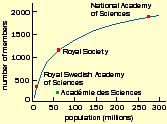Author
Array
(
[0] => linkedin
[1] => facebook
[2] => twitter
[3] => google-plus
[4] => youtube
)
Array
(
[0] => linkedin
[1] => facebook
[2] => twitter
[3] => google-plus
[4] => youtube
)
Array
(
[0] => linkedin
[1] => facebook
[2] => twitter
[3] => google-plus
[4] => youtube
)
Array
(
[0] => linkedin
[1] => facebook
[2] => twitter
[3] => google-plus
[4] => youtube
)
Array
(
[0] => linkedin
[1] => facebook
[2] => twitter
[3] => google-plus
[4] => youtube
)
No Author
Author archive
 Read article: Ethics enters the 21st century
Read article: Ethics enters the 21st century
When the great and the good met at the World Conference on Science in Budapest in June, one question was on many people’s lips. How much has science changed since the previous World Conference held in Vienna 20 years before? One major development has been, of course, the collapse of science in eastern Europe and […]
 Read article: Isidor Isaac Rabi: walking the path of God
Read article: Isidor Isaac Rabi: walking the path of God
I I Rabi's work on the magnetic properties of nuclei, including the development of nuclear magnetic resonance, and his role as a peace campaigner during the Cold War have had profound and far-reaching effects throughout physics
 Read article: Superconductor stripes move on
Read article: Superconductor stripes move on
There is an old joke about a farmer who has a hen that will not lay eggs. After consulting unsuccessfully with a biologist, and then a chemist, he finally turns to a theoretical physicist. Several days later, the physicist announces that he has solved the problem: “First we assume a spherical chicken…” This story is […]

One clear result from the reader survey distributed with the July issue of Physics World was the large number of you who want more articles on the history and philosophy of physics. This came as a big surprise to us. We thought that we had responded to a similar message in our 1996 survey by […]

Benetton recently signed a two-year partnership with AEA Technology, the UK science and engineering services firm. They believe that AEA’s knowledge of materials will make their cars lighter and faster. Pat Symonds, technical director of Benetton Formula One, says that the deal will “enable us to apply technologies far in advance of anything that we […]

Physicists have been attempting to create a vortex in a dilute Bose condensate since these systems were first created in 1995. In principle, atomic condensates are ideal systems in which to study vortices because they can now be created and probed routinely using lasers and microwaves (see Physics World August 1999). However, a direct demonstration […]

Investment in “knowledge”, which is defined as research and development, software and public spending on education, now accounts for 8% of the OECD’s total gross domestic product (GDP). Expenditure on knowledge is highest in Scandinavia and France (9-10% of GDP), and lowest in Italy and Japan (6-7%). OECD countries also invested an average of 7% […]

The survey is similar to a study of engineering research being undertaken by the Royal Academy of Engineering and will draw on existing data, assessments from a body of selected international experts, and site visits. The exercise will cover all physics research carried out by or for the research councils in universities, central laboratories and […]

Light is emitted from a quantum cascade laser when an electron falls from an excited energy level in a quantum well to a lower level. The quantum wells are defined by alternating layers of semiconductors with different energy gaps. When an appropriate voltage is applied to the device the electron then tunnels from this lower […]

Like ESA’s recent Hipparcos mission, FAME will use the parallax method to determine the stars’ positions: as the telescope and the Earth orbit the sun, the position of the stars will change slightly. The smaller the change, the further the star is from the Earth. FAME will also look in two directions at once to […]
Copyright © 2025 by IOP Publishing Ltd and individual contributors
 Read article: Ethics enters the 21st century
Read article: Ethics enters the 21st century


